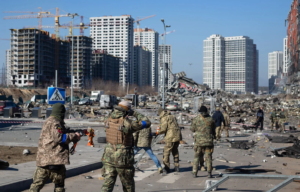Physical Address
23,24,25 & 26, 2nd Floor, Software Technology Park India, Opp: Garware Stadium,MIDC, Chikalthana, Aurangabad, Maharashtra – 431001 India
Physical Address
23,24,25 & 26, 2nd Floor, Software Technology Park India, Opp: Garware Stadium,MIDC, Chikalthana, Aurangabad, Maharashtra – 431001 India

On February 24, 2022, the Russian Federation initiated an unprovoked, large-scale invasion of Ukraine. Now, over two years later, the war persists, creating a humanitarian crisis with numerous casualties, injuries, and widespread displacement. The conflict has severely damaged and destroyed civilian infrastructure, such as buildings, factories, and roads. Furthermore, the war has ravaged natural ecosystems and caused environmental pollution. Numerous industrial facilities have been struck, resulting in uncontrolled chemical releases. Additionally, forests and nature reserves have suffered considerable damage. A recent study by the Initiative on Greenhouse Gas Accounting of War (IGGAW) – a research collective partly funded by the German and Swedish governments, and the European Climate Foundation revealed that the climate impact of the first two years of Russia’s war on Ukraine surpassed the annual greenhouse gas emissions produced by 175 individual countries.
The report found:
Direct Effect
In addition to environmental pollution and land degradation in Ukraine, a direct consequence of the war is the substantial emissions of greenhouse gases (GHG). At a time when the global community is striving to dramatically reduce GHG emissions to limit the average global temperature increase to 1.5°C, the additional emissions caused by the war exacerbate the challenges in addressing the climate crisis.
Indirect Effect
The full-scale invasion has created a more insecure world, prompting a rise in military spending, particularly on the European continent. Since militaries account for 5.5% of global emissions, this increase in military expenditure will inevitably result in higher military emissions worldwide.
Emissions from warfare activities
Emissions resulting from warfare continue to grow. The study found that the fuel consumption has steadily risen each month, both at the frontline and in the supply chain of the armed forces. Although the rate of artillery use has decreased compared to the first year of the war, the production of large quantities of ammunition has significantly increased in Russia, Ukraine, and elsewhere to replenish dwindling stocks.
Also, carbon-intensive explosives, steel, and other materials have surged for ammunition production.
Russia and Ukraine have constructed and continued expanding and strengthening hundreds of kilometers of fortifications along and behind the frontlines. Additionally, Ukraine has implemented a large-scale program to build protective layers for critical energy infrastructure and install concrete shelters in cities and towns to protect civilians. The extensive use of carbon-intensive materials, such as steel and concrete, has resulted in increased carbon emissions, the researchers found in the study.
Emissions from damaged energy infrastructure
In the first weeks of the war, Russia attacked numerous Ukrainian fossil fuel depots and refineries, causing many tonnes of oil products to go up in flames and resulting in significant GHG emissions. Large-scale attacks on the Ukrainian electricity network caused many uncontrolled leakages of SF6, the strongest existing greenhouse gas. Additional GHG emissions were caused by the damage and destruction of natural gas transportation and distribution infrastructure in Ukraine, as well as the long-term fire on a natural gas production platform in the Black Sea.
The fourth assessment has estimated these emissions for the first time. They are compounded by the sabotage of the Nord Stream 1 & 2 natural gas pipelines, which resulted in the largest methane leak ever observed. Total emissions are estimated at 17.2 million tCO2e.
Reconstruction of damaged infrastructure
Many buildings in Ukraine including apartment blocks, hospitals, kindergartens, and various commercial and industrial structures, have been damaged or destroyed. Utilities, roads, vehicles, and industries have also sustained significant damage. Reconstruction efforts are underway, particularly in the liberated areas north of Kyiv, east of Kharkiv, and in the Kherson region.
Emissions due to the detour of Aviation routes
The closure of Ukraine’s airspace to commercial traffic, along with airspace bans imposed by Western countries and Russia, has disrupted crucial east-west air routes between Europe and Asia for numerous Western carriers. This closure has rendered nearly 18 million square kilometers inaccessible for overflights. As a result, airlines have been compelled to take detours on routes to East and Southeast Asia, leading to extended flight durations, increased fuel expenditures, and higher greenhouse gas emissions.
Due to increased oil prices and longer flight durations caused by route detours following airspace closures, multiple factors have disrupted pre-war flight routes. These disruptions have significantly impacted flight schedules, leading some airlines to operate at reduced capacities compared to their pre-war levels.
With 175 million tonnes of CO2 equivalent emitted during 24 months of the war, the total climate damage amounts to over USD 32 billion.
With Inputs from Aayushi Sharma
References:
https://en.ecoaction.org.ua/wp-content/uploads/2024/06/Climate-Damage-Caused-by-War-24-months-EN.pdf
https://www.gov.uk/government/statistics/uks-carbon-footprint
Image Source:
https://www.britannica.com/event/2022-Russian-invasion-of-Ukraine#/media/1/2204815/300221
https://www.britannica.com/event/2022-Russian-invasion-of-Ukraine#/media/1/2204815/235571
Banner Image Source: https://www.britannica.com/event/2022-Russian-invasion-of-Ukraine#/media/1/2204815/269132
Comments are closed.
PrAqxUamiHWBp